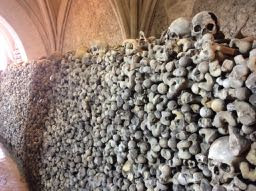We visited the seaside at Hythe in Kent, one of the five Cinque ports, on Saturday. Hythe is a pleasant little market town, although nothing like as pretty as Rye or Winchelsea.
The highlight of Hythe for medievalists is found beneath St Leonard’s Church. The church itself is an enormous edifice up on the hill, largely built in the fourteenth century, with features going back to the eleventh century. That is all quite typical of an old Kentish church, and luckily St Leonard’s has been left relatively unscathed by the dreaded Victorian Church Restorers.
Under the chancel, there is a long-forgotten chamber that holds a remarkable collection of medieval bones. Over a thousand skulls are neatly arrayed in racks and there is a huge neat stack of bones. Local legend claims that these are victims of the Battle of Hastings, but analysis has revealed the majority are women, and there are few wounds in evidence. The crypt’s attendant had a much more prosaic explanation for where the bones came from: when the chancel was built in the fourteenth century, much of the churchyard was dug up. The bones of parishioners found during the building work were stored in the cellar of the church and forgotten about for centuries. The earliest references to the ossuary date from the seventeenth century and the current layout, with its neat stack of bones, was assembled in 1910. The collection has recently yielded interesting information on the health of medieval people, which wasn’t great.
The crypt is not as spooky as an old room housing thousands of human bones might be. There are large windows providing plenty of natural light and the skulls seem content to mind their own business as we tourists passed through. But I found that if I stopped to examine the bones more closely they ceased to be gothic decor and became the remains of individuals. Once, these grey and decaying relics were people who were in the centre of their own universes, just like I am in mine. The owners of some of these skulls knew and maybe loved the owners of others. Now every one of them is anonymous and unknown. The dead are democrats as they all now count for the same.
While ossuaries are not uncommon on the Continent, there is nothing else quite like the St Leonard’s crypt in England. It is generally open over the summer and well worth a visit.
Discuss this post at the Quodlibeta Forum
Tweet
Monday, April 17, 2017
Thursday, April 13, 2017
New articles on science and religion/history of science
Although my new book is on What Everyone Needs to Know about Tax, I have been contributing to various books on the history of science, and on science and religion in the last few years.
 First up, and out this month in the US, is the Dictionary of Christianity and Science (Zondervan, 2017). This is a massive new encyclopaedia to which I was invited to contribute a number of the historical articles, including on Giordano Bruno, Hypatia and biblical chronology. Although it is edited from an evangelical perspective, it contains a wide variety of viewpoints and looks like a useful resource for anyone interested in the intersection between science and Christianity.
First up, and out this month in the US, is the Dictionary of Christianity and Science (Zondervan, 2017). This is a massive new encyclopaedia to which I was invited to contribute a number of the historical articles, including on Giordano Bruno, Hypatia and biblical chronology. Although it is edited from an evangelical perspective, it contains a wide variety of viewpoints and looks like a useful resource for anyone interested in the intersection between science and Christianity.
 I have also written an introduction to a collection of academic articles published last year in Medieval Science Fiction (KCLMS, 2016). This is a rather pricey academic tome, but an expanded version of my introduction is available at my web site. To help get to grips with how ordinary medieval people viewed the cosmos, in this piece I’ve mined some of the most significant works of medieval literature for nuggets of scientific wisdom. I was quite pleased with how it came out. Other contributors to the volume include Michael Flynn, well known in these parts (that’s the science fiction writer rather than Trump’s erstwhile advisor).
I have also written an introduction to a collection of academic articles published last year in Medieval Science Fiction (KCLMS, 2016). This is a rather pricey academic tome, but an expanded version of my introduction is available at my web site. To help get to grips with how ordinary medieval people viewed the cosmos, in this piece I’ve mined some of the most significant works of medieval literature for nuggets of scientific wisdom. I was quite pleased with how it came out. Other contributors to the volume include Michael Flynn, well known in these parts (that’s the science fiction writer rather than Trump’s erstwhile advisor).
 A few years back, I wrote a chapter on the history of popular science for a book on Successful Science Communication (Cambridge University Press, 2011). I’ve added that chapter to my website as well. It is a whistle stop tour of how scientists have communicated with the general public, from ancient Greece to the present day.
A few years back, I wrote a chapter on the history of popular science for a book on Successful Science Communication (Cambridge University Press, 2011). I’ve added that chapter to my website as well. It is a whistle stop tour of how scientists have communicated with the general public, from ancient Greece to the present day.
Finally, if you are in the UK or Europe and would like a signed copy of my book God’s Philosophers: How the Medieval World Laid the Foundations of Modern Science, then I have a few available and will happily inscribe one with a message of your choice. You can order from the website. Sorry, but for licensing reasons, I can’t sell copies to the US where there is a separate edition of the same book called The Genesis of Science: How the Christian Middle Ages Launched the Scientific Revolution. The hardback is now only $15 on Amazon.com.
Discuss this post at the Quodlibeta Forum
Tweet
 First up, and out this month in the US, is the Dictionary of Christianity and Science (Zondervan, 2017). This is a massive new encyclopaedia to which I was invited to contribute a number of the historical articles, including on Giordano Bruno, Hypatia and biblical chronology. Although it is edited from an evangelical perspective, it contains a wide variety of viewpoints and looks like a useful resource for anyone interested in the intersection between science and Christianity.
First up, and out this month in the US, is the Dictionary of Christianity and Science (Zondervan, 2017). This is a massive new encyclopaedia to which I was invited to contribute a number of the historical articles, including on Giordano Bruno, Hypatia and biblical chronology. Although it is edited from an evangelical perspective, it contains a wide variety of viewpoints and looks like a useful resource for anyone interested in the intersection between science and Christianity.  I have also written an introduction to a collection of academic articles published last year in Medieval Science Fiction (KCLMS, 2016). This is a rather pricey academic tome, but an expanded version of my introduction is available at my web site. To help get to grips with how ordinary medieval people viewed the cosmos, in this piece I’ve mined some of the most significant works of medieval literature for nuggets of scientific wisdom. I was quite pleased with how it came out. Other contributors to the volume include Michael Flynn, well known in these parts (that’s the science fiction writer rather than Trump’s erstwhile advisor).
I have also written an introduction to a collection of academic articles published last year in Medieval Science Fiction (KCLMS, 2016). This is a rather pricey academic tome, but an expanded version of my introduction is available at my web site. To help get to grips with how ordinary medieval people viewed the cosmos, in this piece I’ve mined some of the most significant works of medieval literature for nuggets of scientific wisdom. I was quite pleased with how it came out. Other contributors to the volume include Michael Flynn, well known in these parts (that’s the science fiction writer rather than Trump’s erstwhile advisor). A few years back, I wrote a chapter on the history of popular science for a book on Successful Science Communication (Cambridge University Press, 2011). I’ve added that chapter to my website as well. It is a whistle stop tour of how scientists have communicated with the general public, from ancient Greece to the present day.
A few years back, I wrote a chapter on the history of popular science for a book on Successful Science Communication (Cambridge University Press, 2011). I’ve added that chapter to my website as well. It is a whistle stop tour of how scientists have communicated with the general public, from ancient Greece to the present day. Finally, if you are in the UK or Europe and would like a signed copy of my book God’s Philosophers: How the Medieval World Laid the Foundations of Modern Science, then I have a few available and will happily inscribe one with a message of your choice. You can order from the website. Sorry, but for licensing reasons, I can’t sell copies to the US where there is a separate edition of the same book called The Genesis of Science: How the Christian Middle Ages Launched the Scientific Revolution. The hardback is now only $15 on Amazon.com.
Discuss this post at the Quodlibeta Forum
Tweet


